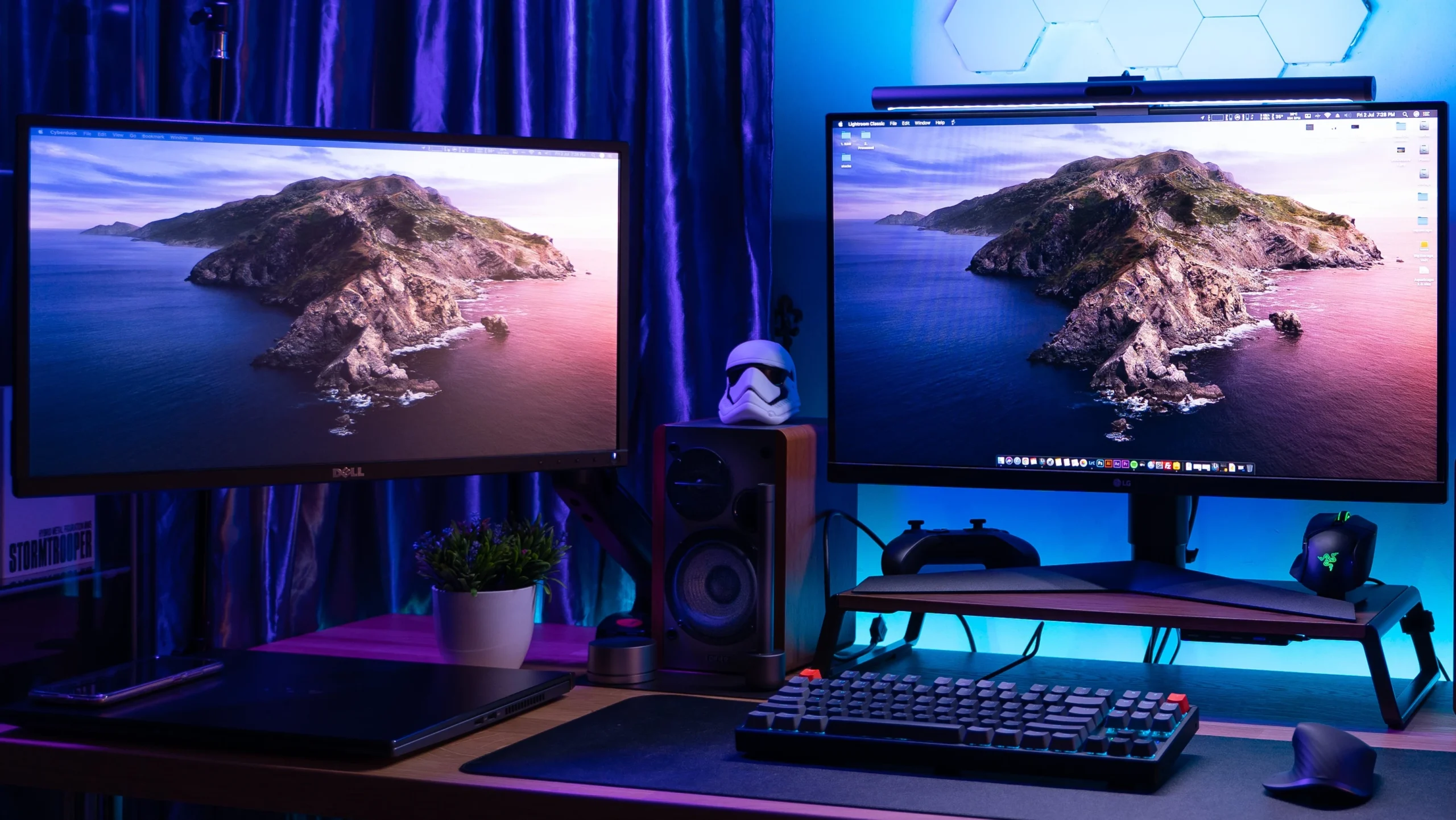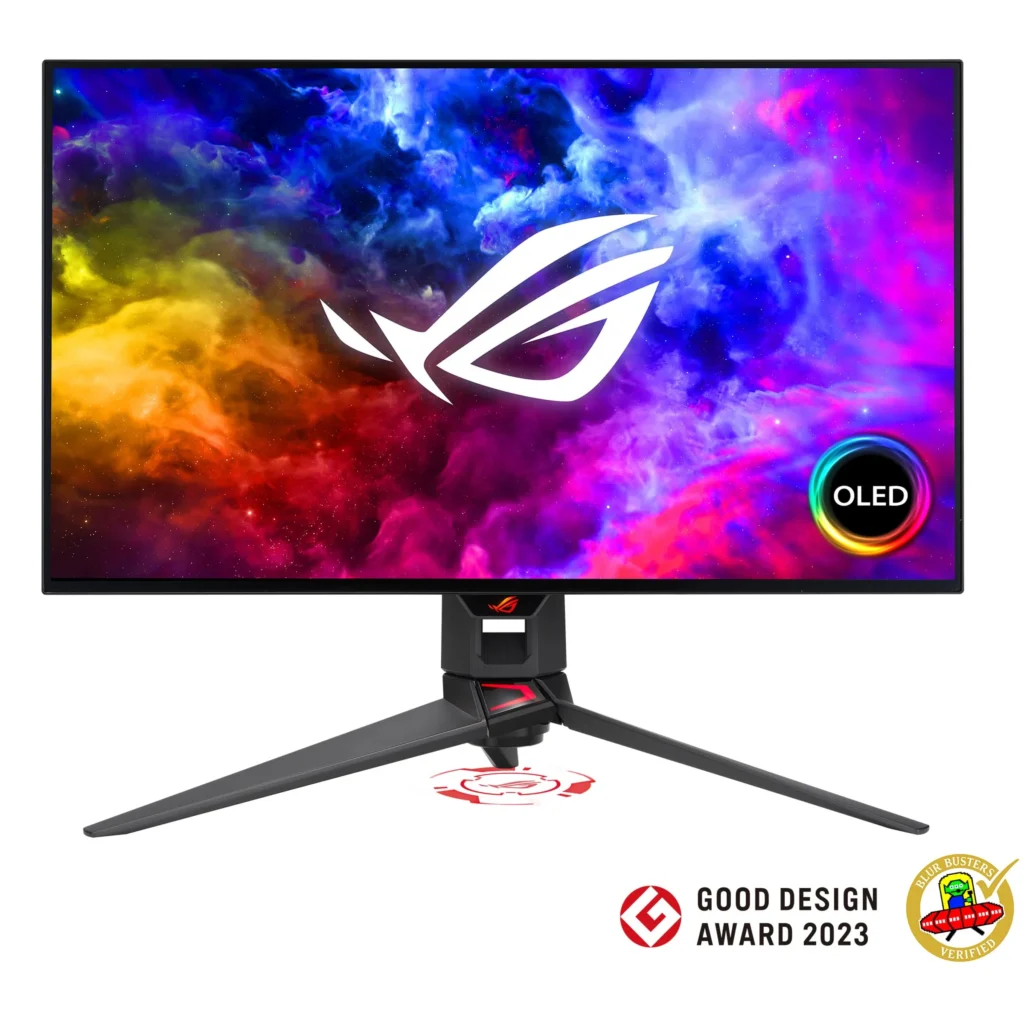
The Best Gaming Monitors for 2025
Gaming monitors have come a long way in 2025. Today’s screens offer stunning visuals and lightning-fast performance to elevate your gaming experience. The Samsung Odyssey OLED G8 stands out as the best gaming monitor of 2025, featuring a 4K QD-OLED display with a 240Hz refresh rate.
When choosing a gaming monitor, you’ll want to consider key factors like resolution, refresh rate, and panel type. 4K resolution delivers crisp details, while high refresh rates of 144Hz or more ensure smooth motion. OLED and mini-LED technologies provide exceptional contrast and vibrant colors.
Response time is crucial for competitive gaming. Look for monitors with 1ms or lower response times to minimize motion blur and ghosting. Adaptive sync technologies like FreeSync and G-Sync help eliminate screen tearing for a seamless experience. Consider your specific needs and budget to find the perfect balance of features.
| Feature | Importance | Examples |
|---|---|---|
| Resolution | High | 4K, 1440p |
| Refresh Rate | Very High | 144Hz, 240Hz |
| Panel Type | High | OLED, IPS, VA |
| Response Time | High | 1ms, 0.5ms |
| Adaptive Sync | Medium | FreeSync, G-Sync |

Top 10 Gaming Monitors (2025)
It’s important to note that “best” is subjective and depends on individual needs and preferences. This list combines performance, features, and overall value, considering various factors like resolution, refresh rate, response time, panel type, and price.
| Rank | Monitor | Panel Type | Resolution | Refresh Rate | Response Time | Key Features |
|---|---|---|---|---|---|---|
| 1 | ASUS ROG Swift OLED PG27AQDM | OLED | 1440p | 240Hz | 0.03ms (GtG) | Incredible contrast, fast response, G-SYNC Compatible |
| 2 | LG 27GR95QE-B | OLED | 1440p | 240Hz | 0.03ms (GtG) | Fast and responsive, great for competitive gaming |
| 3 | Samsung Odyssey OLED G8 (G85SB) | QD-OLED | 3440×1440 (Ultrawide) | 175Hz | 0.1ms (GtG) | Immersive ultrawide, vibrant colors |
| 4 | MSI MEG 342C QD-OLED | QD-OLED | 3440×1440 (Ultrawide) | 175Hz | 0.1ms (GtG) | Excellent contrast, wide color gamut |
| 5 | Alienware AW3423DW | QD-OLED | 3440×1440 (Ultrawide) | 175Hz | 0.1ms (GtG) | Curved ultrawide, great for immersion |
| 6 | ASUS ROG Swift PG32UQ | IPS | 4K | 144Hz | 1ms (GtG) | High resolution, good color accuracy |
| 7 | Gigabyte M27QX | IPS | 1440p | 170Hz | 0.5ms (MPRT) | Fast response, good value |
| 8 | Samsung Odyssey G7 (G70B) | VA | 1440p | 240Hz | 1ms (MPRT) | High refresh rate, good contrast |
| 9 | LG 27GP850-B | IPS | 1440p | 180Hz (OC) | 1ms (GtG) | Well-rounded performance, good color |
| 10 | ViewSonic Elite XG270QG | IPS | 1440p | 165Hz | 1ms (GtG) | G-SYNC, good image quality |
Choosing the Right Gaming Display for 2025
Understanding Key Features
Picking a gaming monitor involves more than just size. Several key features impact your gaming experience. Let’s look at the most important ones:
Resolution
Resolution affects image sharpness. Common resolutions include:
- 1080p (Full HD): Good for high refresh rates and less demanding on your PC.
- 1440p (QHD): A great balance of detail and performance. Many gamers prefer this.
- 4K (Ultra HD): The sharpest image, but requires a powerful graphics card.
Refresh Rate
Refresh rate measures how many times the screen updates per second. Higher refresh rates mean smoother motion. Look for at least 144Hz for serious gaming. Some monitors now offer 240Hz or even higher.
Response Time
Response time measures how quickly a pixel changes color. Lower is better, reducing motion blur. Look for 1ms or lower for the best results.
Panel Technology
Different panel types offer various advantages:
- OLED: Offers perfect blacks, incredible contrast, and fast response times. It’s becoming very popular for gaming.
- IPS: Provides excellent color accuracy and wide viewing angles. A good all-around choice.
- VA: Offers high contrast ratios and good black levels, but response times can be slower than IPS or OLED.
Adaptive Sync
Adaptive sync technologies like G-SYNC (Nvidia) and FreeSync (AMD) reduce screen tearing and stuttering, making gameplay smoother.
Top Monitor Contenders for 2025
OLED technology is making a big splash in gaming monitors. We expect more models with improved features and potentially lower prices. Mini-LED backlighting will also likely improve for LCD monitors, offering better contrast and HDR.
Here are some examples of monitors with features we expect to see more of in 2025:
| Monitor Feature | Description |
|---|---|
| QD-OLED Panels | Combine OLED’s perfect blacks with Quantum Dot technology for vibrant colors. |
| High Refresh Rates | Expect more 240Hz and even higher refresh rate monitors. |
| Ultrawide and Super-Ultrawide | These offer immersive gaming experiences with wider aspect ratios. |
| Improved HDR | Higher peak brightness and better local dimming for more realistic HDR. |
When choosing a monitor, consider your budget, the types of games you play, and the features most important to you.
Technological Advances in Gaming Monitors
Gaming monitors have seen rapid improvements in display technology, refresh rates, and resolution. These advancements offer enhanced visuals and smoother gameplay for an immersive gaming experience.
OLED and QD-OLED Panels
OLED technology has revolutionized gaming displays with its self-emitting pixels. This results in perfect blacks, infinite contrast ratios, and vivid colors. OLED gaming monitors provide faster response times compared to traditional LCD panels.
QD-OLED combines OLED with quantum dot technology. This hybrid offers even better color accuracy and brightness. The Samsung Odyssey OLED G8 is a prime example, featuring a 32-inch QD-OLED panel with 4K resolution.
Benefits of OLED and QD-OLED for gaming:
- Deeper blacks and better contrast
- Wider color gamut
- Reduced motion blur
- Lower input lag
High Refresh Rates
Modern gaming monitors now boast refresh rates of 240Hz and beyond. This leap from standard 60Hz displays results in smoother motion and reduced screen tearing.
High refresh rates are particularly beneficial for competitive gaming. They allow for quicker reactions and more fluid gameplay. Many premium gaming monitors now offer 360Hz refresh rates for ultra-responsive gaming.
Adaptive sync technologies like FreeSync and G-Sync complement high refresh rates. They synchronize the monitor’s refresh rate with the GPU’s output to eliminate screen tearing.
| Refresh Rate | Benefits |
|---|---|
| 144Hz | Smooth gameplay, reduced motion blur |
| 240Hz | Enhanced fluidity, faster response times |
| 360Hz | Competitive edge, minimal input lag |
Resolution Evolution
4K resolution (3840 x 2160) has become more accessible in gaming monitors. It offers sharper images and more detailed textures compared to 1080p or 1440p displays.
The jump to 4K does require more powerful GPUs to maintain high frame rates. However, DLSS and FSR upscaling technologies help bridge this performance gap.
Some manufacturers are pushing beyond 4K. 5K and 8K gaming monitors are emerging, though they remain niche due to high costs and extreme hardware requirements.
1440p (2560 x 1440) remains a popular middle ground. It offers a noticeable upgrade over 1080p without the performance demands of 4K. Many gamers find 1440p to be the sweet spot for both visual quality and smooth framerates.
Features and Performance
Gaming monitors in 2025 offer advanced capabilities to enhance gameplay. Key advancements include faster response times, variable refresh rates, and improved picture quality.
Response Times and Input Lag
Modern gaming monitors boast impressive response times and low input lag. Many top models now feature 1ms response times, ensuring smooth motion with minimal ghosting or blurring. This is crucial for competitive gaming where every millisecond counts.
Input lag has also seen significant improvements. High-end monitors now offer input lag as low as 0.5ms. This means your actions translate to on-screen movement almost instantly.
To achieve the best performance:
- Look for monitors with “Ultra Low Motion Blur” technology
- Enable game mode to reduce processing and decrease lag
- Use DisplayPort connections for lowest latency
Variable Refresh Rate Technologies
Variable refresh rate (VRR) technologies like FreeSync and G-Sync have become standard features. These technologies synchronize your monitor’s refresh rate with your GPU’s frame output.
Benefits of VRR:
- Eliminates screen tearing
- Reduces stuttering
- Improves overall smoothness
FreeSync monitors are more common and work with both AMD and NVIDIA GPUs. G-Sync monitors tend to be pricier but offer slightly better performance with NVIDIA cards.
Many new monitors support both technologies, giving you flexibility regardless of your GPU choice.
Picture Quality and Color Accuracy
Gaming monitors now rival professional displays in terms of picture quality and color accuracy. HDR (High Dynamic Range) has become a standard feature, offering brighter highlights and deeper blacks.
Key picture quality factors:
| Feature | Impact on Gaming |
|---|---|
| Contrast Ratio | Deeper blacks, better visibility in dark scenes |
| Color Gamut | Wider range of colors, more vibrant visuals |
| HDR | Enhanced brightness and contrast |
OLED and QD-OLED panels are gaining popularity due to their superior contrast and color reproduction. These technologies offer true blacks and vibrant colors that enhance immersion in games.
For color accuracy, look for monitors with factory calibration. Many gaming monitors now come pre-calibrated, ensuring accurate colors out of the box.
Connectivity and Compatibility
Modern gaming monitors offer various connectivity options to support different devices and setups. The right ports and features can enhance your gaming experience and streamline your setup.
HDMI 2.1 and DisplayPort Options
HDMI 2.1 is essential for high-refresh-rate 4K gaming. It supports up to 48 Gbps bandwidth, allowing 4K resolution at 120Hz or even 144Hz. This makes it ideal for both PC gaming and next-gen consoles like the PS5 and Xbox Series X.
DisplayPort 1.4 remains popular for PC gaming. It supports high refresh rates and resolutions, including 4K at 144Hz with Display Stream Compression (DSC). Some monitors now feature DisplayPort 2.0, offering even higher bandwidth for future-proof performance.
Consider a monitor with multiple HDMI 2.1 ports if you plan to connect several high-performance devices. For PC-focused setups, look for at least one DisplayPort input.
| Port Type | Max Resolution | Max Refresh Rate |
|---|---|---|
| HDMI 2.1 | 4K | 144Hz |
| DP 1.4 | 4K | 144Hz (with DSC) |
| DP 2.0 | 8K | 60Hz |
KVM Switches and Multi-Device Use
KVM (Keyboard, Video, Mouse) switches are becoming more common in gaming monitors. They let you control multiple devices with a single set of peripherals. This is useful if you use both a gaming PC and a work laptop.
Look for monitors with built-in KVM functionality and USB-C connectivity. USB-C can carry video, data, and power in one cable, simplifying your setup. Some monitors offer up to 90W power delivery, enough to charge most laptops.
Multi-device support is crucial for streamlined setups. Picture-in-Picture (PiP) and Picture-by-Picture (PbP) modes let you view content from different sources simultaneously.
Gaming Consoles and PC Gaming
For console gaming, prioritize HDMI 2.1 ports. This ensures compatibility with the PS5 and Xbox Series X, allowing 4K 120Hz gameplay. Variable Refresh Rate (VRR) support is also key for smooth gaming on both consoles and PCs.
PC gamers should look for DisplayPort connections for the highest refresh rates and resolutions. G-Sync or FreeSync compatibility helps eliminate screen tearing and stuttering.
Ultra-wide monitors are popular for PC gaming, offering immersive experiences. However, they may not be fully supported by consoles, which typically output 16:9 aspect ratios.
Consider a monitor with low input lag and fast response times for competitive gaming. Look for 1ms response times and input lag below 5ms for the best performance.
Best Gaming Monitors by Category
Gaming monitors come in various types to suit different needs and budgets. The right choice depends on your gaming preferences and hardware setup.
Top Picks for Competitive Gaming
For competitive gamers, high refresh rates and low response times are crucial. The Alienware AW3225QF stands out with its 360Hz refresh rate and 0.5ms response time. This 32-inch QD-OLED monitor offers stunning visuals and smooth gameplay.
1440p gaming monitors strike a balance between performance and visual quality. The LG UltraGear 32GS95UE features a 240Hz refresh rate and HDR1000 certification. It’s ideal for fast-paced shooters and racing games.
For esports enthusiasts, 24-inch 1080p monitors remain popular. They offer high frame rates and quick pixel response, giving you a competitive edge in games where every millisecond counts.
Budget-Friendly Choices
You don’t need to break the bank for a good gaming experience. Many budget gaming monitors offer excellent value. Look for 1080p monitors with 144Hz refresh rates and 1ms response times.
IPS panels provide better color accuracy and viewing angles compared to TN panels. VA panels offer deeper blacks and higher contrast ratios, making them great for atmospheric games.
Consider these features in budget monitors:
| Feature | Benefit |
|---|---|
| FreeSync/G-Sync | Reduces screen tearing |
| Low Blue Light | Reduces eye strain |
| Adjustable Stand | Improves ergonomics |
Some budget models even offer 1440p resolution, giving you sharper images without a hefty price tag.
Premium Gaming Monitor Selections
For those seeking the ultimate gaming experience, premium monitors offer cutting-edge technology. The Samsung Odyssey OLED G8 delivers exceptional picture quality with its QD-OLED panel and 240Hz refresh rate at 4K resolution.
The MSI MPG 321URX QD-OLED is another top choice. It boasts a 32-inch 4K display with a 240Hz refresh rate and 0.1ms response time. The QD-OLED technology provides vibrant colors and deep blacks.
These premium monitors often include:
- HDMI 2.1 for next-gen console support
- USB-C connectivity for easy laptop hookup
- KVM switches for multi-device setups
While pricey, they offer future-proof features and unparalleled visual quality for both gaming and content creation.
Frequently Asked Questions
Gaming monitors in 2025 offer advanced features and technologies to enhance the gaming experience. Let’s explore key aspects of selecting the right monitor for your needs.
What features define the top gaming monitors in 2025?
Top gaming monitors in 2025 boast high refresh rates of 240Hz or more. They also feature low response times under 1ms. Many use OLED or mini-LED technology for improved contrast and color accuracy.
Variable refresh rate technologies like FreeSync and G-Sync are standard. These prevent screen tearing and stuttering during gameplay.
How do 4K monitors compare to 1440p monitors for a premium gaming experience?
4K monitors offer sharper image quality with more detailed textures. They’re ideal for immersive single-player games and content creation.
1440p monitors balance performance and visual quality. They allow for higher frame rates on less powerful hardware. This makes them popular for competitive gaming.
When selecting a gaming monitor, what are the advantages of OLED technology?
OLED displays provide superior contrast ratios and deeper blacks. They offer faster response times than traditional LCD panels.
OLED gaming monitors produce vivid colors and wider viewing angles. This technology excels in reproducing HDR content for more lifelike visuals.
For competitive gaming, which monitors are preferred by professional gamers in 2025?
Pro gamers favor monitors with ultra-high refresh rates of 360Hz or more. Low input lag and fast response times are crucial for split-second reactions.
TN panels remain popular for their speed. However, newer IPS and OLED options now offer comparable performance with better color reproduction.
What are the top recommended gaming monitors for PS5 users in 2025?
PS5 users benefit from monitors supporting 4K resolution at 120Hz. HDMI 2.1 connectivity is essential for full compatibility.
VRR support ensures smooth gameplay. Look for monitors with HDR capabilities to take advantage of the PS5’s visual enhancements.
What are the best budget-friendly gaming monitors available in 2025?
Budget-friendly options in 2025 include 1080p monitors with 144Hz refresh rates. These provide smooth gameplay without breaking the bank.
Some affordable 1440p monitors offer a good balance of resolution and performance. VA panels are common in this range, offering good contrast at lower prices.
| Feature | Budget | Mid-range | High-end |
|---|---|---|---|
| Resolution | 1080p | 1440p | 4K |
| Refresh Rate | 144Hz | 240Hz | 360Hz+ |
| Panel Type | VA | IPS | OLED |
| HDR | Basic | HDR600 | HDR1000+ |
| Size | 24-27″ | 27-32″ | 32″+ |



